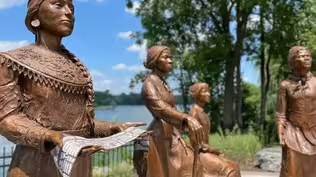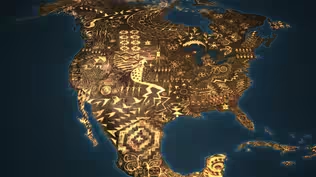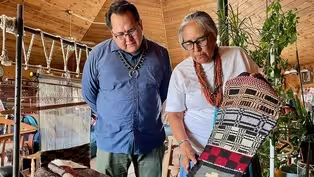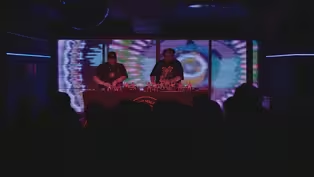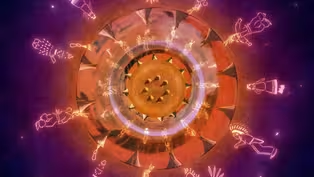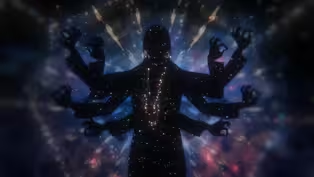
New Worlds
10/24/2023 | 53m 35sVideo has Audio Description, Closed Captions
Native innovators lead a revolution in music, building, and space exploration.
Native innovators lead a revolution in music, building, and space exploration. From the surface of Mars to the New York City hip hop scene to the Pine Ridge Reservation, Native traditions are transforming life on Earth and other worlds.
See all videos with Audio DescriptionADProblems playing video? | Closed Captioning Feedback
Problems playing video? | Closed Captioning Feedback
Funding is provided by Partnership with Native Americans.

New Worlds
10/24/2023 | 53m 35sVideo has Audio Description, Closed Captions
Native innovators lead a revolution in music, building, and space exploration. From the surface of Mars to the New York City hip hop scene to the Pine Ridge Reservation, Native traditions are transforming life on Earth and other worlds.
See all videos with Audio DescriptionADProblems playing video? | Closed Captioning Feedback
How to Watch Native America
Native America is available to stream on pbs.org and the free PBS App, available on iPhone, Apple TV, Android TV, Android smartphones, Amazon Fire TV, Amazon Fire Tablet, Roku, Samsung Smart TV, and Vizio.
Buy Now
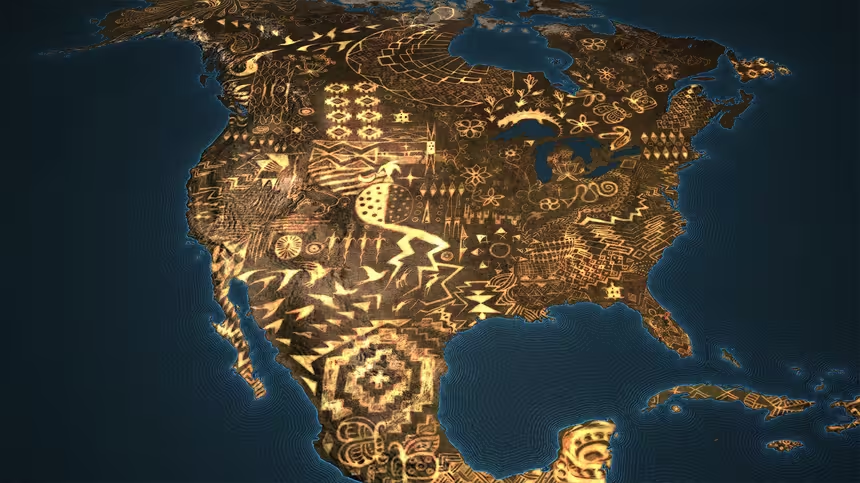
Listen to Native Voices
Explore an interactive map, which features speakers of Native languages in their own voices from across North America.Providing Support for PBS.org
Learn Moreabout PBS online sponsorshipNARRATOR: Playing with rocks on the Rez leads to searching for life on Mars.
AARON YAZZIE: I can come home and I can find myself in a place that's very much like Mars.
NARRATOR: Ancient drum beats top the hip-hop charts.
TIM HILL: My name is 2oolman and we are the Halluci Nation!
NARRATOR: And tipis inspire a whole new way of building.
HENRY RED CLOUD: We're going to help their dreams for the future come true.
MAN: Go!
NARRATOR: For these Native leaders, the past is the key to building a better future.
♪ ♪ This is "Native America."
♪ ♪ (computer keys clicking) WOMAN (on speaker): We are one minute from entering interface.
NARRATOR: February 18, 2021.
The Perseverance rover lands on Mars.
WOMAN: Touchdown confirmed.
Perseverance safely on the surface of Mars.
(cheering and applauding) ("Remember 01" by the Halluci Nation playing) (song continues) ♪ Let's go!
♪ YAZZIE: We sent Perseverance to Mars in order to collect rock cores to look for signs of ancient microbial life.
And this is actually the star of the show: this is our coring bit.
We drill into a rock, we break it off from the parent rock material, extract that, ingest into the tube, and then we can take that and store it back inside the rover.
♪ ♪ We eventually want to bring these samples back to Earth and study them here to look for signs of ancient microbial life.
NARRATOR: Aaron Yazzie is a NASA aerospace engineer.
He leads the team that created the tools critical to the rover's mission: the drill bits digging into the planet to search for signs of life.
YAZZIE: We're looking in this area on Mars called Jezero Crater, and it's been split up into a bunch of quadrants, and each of these quadrants is named after a different national park around the world.
The Perseverance rover could've landed in any one of these quadrants, but it just so happened that on landing day, our rover landed right in the middle of this one right here, named after Canyon de Chelly National Monument.
Canyon de Chelly is in the middle of the Navajo nation in Arizona.
And it's actually a very important canyon to me as a Navajo engineer and my people.
("Stadium Pow Wow" by the Halluci Nation playing) ♪ Hey!
♪ YAZZIE: We believe in the concept of Hozhó, which is living a life of balance.
♪ Hey!
♪ YAZZIE: And it's the way that you ensure that you're remaining steady and remaining grounded and ensuring that you can remain protected as you travel through life.
(song continues) I go home as much as possible to make sure that I still have that cultural connection.
But also just being on the land, being in a place where our people have been for many, many generations, is also healing.
(song continues) NARRATOR: Long before Aaron Yazzie set his sights on Mars... (man singing) ...Native Americans have been imagining, designing, and engineering new ways of living in the world.
JOHN HERRINGTON: Our ancestors built remarkable structures They used scientific methodology.
They used mathematics in their own way to develop and build these structures.
So it's inherent to who we are, yeah, as Native people that, you know, hey, we can do this.
NARRATOR: Now 21st-century Native leaders continue to carry forward thousands of years of Indigenous knowledge to create a better future on this and other planets.
WOMAN (on speaker): Perseverance continues to report heartbeat tones, indicating everything is nominal.
DWAYNE TOMAH (speaking Passamaquoddy): (birds cawing) (Red Cloud speaking Lakota) The dwelling of the ancestors.
♪ ♪ This is the way that the ancestors moved forward on the plains, migrating with the buffalo.
This is the old way, the old way of, of living.
Each one of the poles represents life, as well.
Nations, generations.
All the stakes is grounded through the Mother Earth.
Totally grounded.
The special tie up there, that special tie is so solid, there's no way that it's going to come apart from the winds or from the weather.
It stands solid and strong.
NARRATOR: Henry Red Cloud is a fifth-generation direct descendant of Chief Red Cloud, Mahpíya Lúta.
Chief Red Cloud was one of the last Lakota war chiefs.
In the early 1800s, Lakota territory spanned the high plains of what is today Montana, Wyoming, Nebraska, and the Dakotas.
It is near Little Big Horn, where Lakota and other warriors defeated General Custer in 1876.
(horse neighs) Their territory also includes Wounded Knee, where an estimated 250 Lakota men, women, and children were massacred by U.S. troops in 1890.
Soon after, the Lakota people were forced onto the Pine Ridge Reservation.
Today, it's one of the poorest places in the country.
RED CLOUD: We're going to step up as 21st-century warriors and we're going to help dreams for the future come true.
So I'm really happy to stand here before you guys.
I'm going to smudge the foundation, and then I'm going to smudge everybody here.
NARRATOR: Like his ancestor Chief Red Cloud, Henry is also waging war.
But on a different front.
His is a battle to build a better future for his people.
(singing in Lakota) (singing continues) RED CLOUD: Here, within the homeland, we need 4,000 homes today.
Within a four-bedroom house, there will be, you know, 30 people.
As you ride across Indian country here, you see a lot of 1970 mobile homes.
You know, two-inch-thick wall and not too much insulation-- pretty much a tin box.
(wind whipping) It gets brutally cold here.
This past winter, we had a minus-26 air temp.
The wind went, began to blow, and then it went, took it to minus-40.
It's not a surprise to hear somebody freezing to death.
We're gonna put it up Lakota-style.
We're gonna put up this tipi structure that way.
Two poles on the east side laying out towards the south and then two on the west side.
Gonna bring the tips together, we'll tie it there, then the rest of us will walk it up.
Okay, that's not going anywhere.
All right, let's do it.
NARRATOR: The poles, based on a traditional tipi, form the structure to lift into place an entirely new kind of home.
Back up a little bit, just straight back, Adam.
(exhales) Go ahead, set it down there.
NARRATOR: Henry's mission is a magnet that attracts innovative builders Aaron Resnick and Jason Mackie.
Initially, Henry asked us, when we came out here to the reservation the first time and we saw the housing problem, he said, "I need something "that someone can survive the winter in for less than $20,000."
I like it.
RESNICK: So we, we said "Okay, we'll try, but that sounds like a challenge."
(power tools buzzing) RED CLOUD: We sat down one evening to look at what would be the best here, low cost with high efficiency, and they came up with this new technique, Foamcrete.
♪ ♪ MACKIE: There is a pretty unique material, it's called cellular concrete, or, on the internet, it's often called Foamcrete or Aircrete.
RESNICK: It's 80% air, it's just full of all these little bubbles.
And so that's the property that makes it super-, super-insulating, so, you know, you can survive minus-40-degree temperatures.
(machine beeps) RED CLOUD: We built two in the past.
We built one, failed on us.
But lessons learned.
So we went back to the drawing board.
And then we built one last year.
NARRATOR: Henry's first shot failed.
The second stood, but was too small.
As his latest design begins to take shape, he remains convinced this home could transform not only Pine Ridge, but many Native communities across Indian country.
RED CLOUD: The structure's taking the old way of the tipi and incorporating it within this Foamcrete.
It actually looks like a tipi.
Hey, we're gonna go face the door east as our ancestors did when they camped.
So let me see here, let me pull out my... Old Indian trick.
(Resnick laughs) RED CLOUD: Everybody carried one of these back in the day.
We're going to be able to step out, greet that morning sun, and then we'll have a walking path into the food right here.
Awesome.
♪ ♪ WOMAN (speaking Lakota): ♪ ♪ NARRATOR: Aaron Yazzie is back home in the Navajo nation.
Though it may seem millions of miles from his work on Mars, Aaron sees it differently.
YAZZIE: Looking around this beautiful landscape, it really feels like I'm in the middle of Mars.
It seems so distant.
It is a world away, right?
But the forces that created this land are the same forces that created the landscapes that are on Mars.
("Remember 02" by the Halluci Nation playing) So I can come home and I can find myself in a place that's very much like Mars.
(song continues) I spent my whole childhood scurrying up and down rocks and sand dunes and canyons just like this.
It's almost like muscle memory.
And so I love to look around and sort of gather inspiration from looking at my own homeland, looking at our own home planet, for when I'm trying to send things to another terrestrial planet, like Mars.
♪ ♪ ♪ ♪ NARRATOR: Aaron Yazzie is visiting Navajo weavers TahNibaa Naataanii and her mother, Sarah Naataanii.
The knowledge of weaving has been passed down through generations.
And with it, a deep understanding of mathematics.
The name of it is bááh dá'áka'í, which means "crackers."
(chuckles) Yeah.
You know how saltine crackers are shaped like a rectangle?
This pattern creates that checkerboard pattern.
YAZZIE: That's cool.
This is a pattern that deities... YAZZIE: Mm-hmm.
TAHNIBAA NAATAANII: ...gave our people by way of our grandmothers and our grandfathers, and so, this twill weave is a very powerful sacred pattern.
And you said it was twill, so that's a slightly different style than...
It's like programming.
Uh-huh.
Computer programming.
It's very specific in its count.
Mm-hmm.
TAHNIBAA NAATAANII: You can kind of think of this bottom weave like arithmetic.
And then as you progress, it gets more complex.
Uh-huh.
So, you graduate from arithmetic to algebra.
(laughs) To geometry.
Yeah.
To trigonometry, to calculus.
Mm-hmm.
To probability and statistics.
TAHNIBAA NAATAANII: It's amazing when we think about our grandmothers and our grandfathers, how they had these numbering sequences in their mind.
YAZZIE: Right.
That's what I always see as what makes a good engineer, is somebody who likes to take on these really tough problems.
Mm.
And when you're done with it, it's very rewarding.
TAHNIBAA NAATAANII: That's the exact feeling it is to be a weaver, YAZZIE: Mm-hmm.
TAHNIBAA NAATAANII: Whether you're weaving a twill weave or you're doing tapestry, like, like Grandma is doing here.
YAZZIE: Uh-huh-- Shimasaní, did you teach TahNibaa how to weave?
(speaking Navajo): You want to try it?
Okay.
(chuckles) All right, you'll have to remind me what...
Okay.
...what sequence we were at.
(laughs) Place that in there, yeah.
Just go all the way.
YAZZIE: Mm-hmm.
TAHNIBAA NAATAANII: Yeah.
And then get the black.
A lot of the patterns have been developed already.
And new patterns are developing based on the older patterns.
YAZZIE: Mm-hmm.
It's similar for us, too, like, we don't, I don't usually have to come up with a completely original idea for the things that I'm building.
There have been, uh, giant drilling assemblies that have gone to Mars before.
And we used a lot of the, the things that they figured out while developing that drill for the drill that we sent on Perseverance.
And so it's sort of this idea of borrowing off the knowledge of those that came before you, because we know that those ways are, are safe and they work.
But also, like, it's all about adapting to new challenges.
("Mother Mother" by the Halluci Nation playing) (song continues) (song continues) NARRATOR: The spirit of the past is being brought into the 21st century through the power of music.
(song continues) ♪ We're 5D formless, spirit ginormous ♪ ♪ Like old growth in the forest that grew here before us ♪ ♪ The bright light inside that matches our auras ♪ ♪ Phosphorescence, an array of auroras ♪ ♪ For the love we fortify for you, all right ♪ ♪ Earth and Sky have a brother spinning like a 45 ♪ ♪ This is not the end, it's the beginning ♪ ♪ Make sure you're alive ♪ ♪ Let the sound shake, yeah, vibrate your poundmaker ♪ (crowd cheering) NARRATOR: Bear Witness and Tim 2oolman Hill are the duo behind the Halluci Nation, an electronic music group that puts a new spin on a traditional beat.
♪ We are the people, we are the future ♪ ♪ We are the land before and after ♪ ♪ We are the people ♪ NARRATOR: Formerly A Tribe Called Red, they perform at venues as diverse as Coachella to TED Talks and have topped the electronic album charts multiple times.
EHREN THOMAS: When we first started, we were just deejays.
And at the time, it was the mash-up era of deejaying.
And we were in a rehearsal session for a big show that we had coming up.
And we had a powwow loop from a grass dance song.
("Stadium Pow Wow" playing) THOMAS: And looped it, and, like, "What's the BPM?
"Oh, it's at 140 BPM."
"Well, that's dubstep."
So threw a dubstep instrumental underneath it, and the two things just clicked so perfectly right away.
It was just, like, "Oh, yeah, of course these work.
It's mixing dance music on dance music."
(crowd cheering and applauding) (song continues) We started this party for our community, but everybody showed up.
We had people from all sorts of backgrounds on the dance floor.
But at 1:00 a.m., we dropped that track, all the Native people in the club would push their way to the front.
(song continues) Our people don't tend to take up a lot of space, right?
500 years of attempted genocide makes you take up a little less space in the world.
(laughs) Maybe not be seen so much, right?
(song continues) But all of a sudden, when we drop those songs, our people push their way to the front of the audience, they throw up their nation flag, they take up space.
They act out that, that, that pride that they, that they feel when they hear those beats.
(song continues) HILL: I'm not an original member, I came in later.
So when I would see these deejays that looked like me playing, you know, music, I've never seen it.
You know, I've never seen anything like it.
(beat playing) (crowd cheering) You know, it really puts things in perspective when you see someone that looks like you on stage presenting music, like, really cool music, especially, and it, it changed my life.
(beat playing) THOMAS: We've always called it a cultural continuance.
We're taking not only the music, but the ideas.
We're taking the values.
Like, all of those things are going in.
We're not just cherry-picking our culture for things that are shiny and, and nice to show people.
("Mother Mother" playing) NARRATOR: The Halluci Nation's music celebrates Native culture.
It captures the party spirit, while at the same time confronting history and today's harsh realities.
♪ ♪ Across 326 reservations, almost a third of families live below the national poverty line.
And Pine Ridge is the poorest.
RED CLOUD: Back in 1995, I felt a calling to return home.
I missed the language, the ceremonies.
So, I returned and had one question for whoever I met, my relatives I haven't saw in years.
I asked them, I said, "If there was a wish that you can have "that can be granted magically to you right here now, what would that be?"
And it didn't take them long to answer.
They said, "I would like to get back to the old homestead "where we coexisted with the Earth.
We were healthy, we were happy."
NARRATOR: Henry Red Cloud is trying to make that wish come true.
He's building new homes based on traditional circular designs, using a totally new material called Aircrete.
(drill whirring) MAN: Kick it in.
NARRATOR: The mold for his prototype is almost complete.
RED CLOUD: Currently, we're putting up the frame.
RED CLOUD: Okay.
RED CLOUD: If it's all good, then the next phase is to pour the Aircrete after that.
We've been working in 106-degree weather.
Everybody's pretty excited, wanting to see what this is going to look like, and bringing this, you know, concept forward.
♪ ♪ RESNICK: Right now, we're gonna start pumping air pressure into it and see if we can get it up to where it needs to be.
This is a scary part of the whole operation.
RESNICK: Let's make sure the valves are all open.
(pump whirring) (cheers) ♪ ♪ (laughing) Oh, this is great.
RED CLOUD: The design of these Foamcrete homes, they're circular, just like our ancestral tipis.
Round is a whole lot better.
A round structure doesn't have these corners for winter wind bellowing up against the corner of the house and making that corner cold.
The energy within a round structure just feels so, you know, comfortable, unique to the Natives here.
This process is kind of a...
It's a work in progress right now.
This is our first time using a system like this, so there's a lot that we've learned.
RED CLOUD: These Aircrete homes just take a matter of days to build, because it's so easy to put together.
RESNICK: If you had enough guys, you could put five up and fill all five of them in a day and take them down and go to the next place.
MACKIE: Then we can build 25 homes a day.
If you got 100 days a year, that's 2,500 homes that can go up in a year, potentially, on a very conservative end.
What happened there?
RED CLOUD: We're training these guys, so it's kind of taking a little bit, but that's okay, because they're gonna be the next tipi warriors.
LEO LEE BEAR, SR.: Like, on every reservation, the waiting lists are, like, thousands and thousands of people we can't get homes for.
With these homes, we can put two, three up a day.
NARRATOR: Leo Lee Bear, Sr., is a member of the Shoshone-Bannock tribe.
He wants to take this technology back to his community.
RED CLOUD: Okay, take it that way.
NARRATOR: If it works.
MAN: So far, so good.
MAN 2: Awesome, looks good.
NARRATOR: The Aircrete in the mold will take at least 14 hours to set.
They won't know if the house will stand until the mold is removed.
RESNICK: How's it looking?
It's looking good.
A couple little leaks, but they stopped.
(exhales) Gonna happen.
Yeah.
RESNICK: As long as they're little ones.
RED CLOUD: There's been a lot of sweat, a lot of good hard work put into this.
We started with a prayer, and then everybody teamed up and worked together.
Right now, as it's being filled, looking at it and that, my heart, my spirit tells me it's all gonna be good.
♪ ♪ WOMAN (speaking Navajo): ♪ ♪ (talking quietly) TAHNIBAA NAATAANII (chuckling): Wow.
YAZZIE: Wow, this is beautiful.
Beautiful.
I really love being back home and coming to this canyon.
This is the birthplace of our Navajo weaving.
Mm-hmm.
This is the home of Spider Woman.
This is the home of Na'ashjé'íí Aszáá and Na'ashjé'íí Hastiin.
Mm, mm.
And those are the holy deities of our, our Navajo people.
Mm-hmm.
At the beginning of our existence, when we were created, this place was also created.
Mm.
And Spider Woman, by bringing weaving to the Navajo people, brought not just that skill, but a lot of other teachings, um, values that we hand on to our younger generations.
Yes, and what's very important to know about this holy, holy ground and the weaving that came to our people is, it is not a legend and it's not a myth.
♪ ♪ TAHNIBAA NAATAANII: It's in our daily lives as weavers and as Navajo people.
♪ ♪ WOMAN (speaking Navajo): ♪ ♪ YAZZIE: For us to exist in a world like this is just a miracle.
♪ ♪ So much has to be perfect in order for life to thrive and exist.
And it's, almost makes us feel like that much more of a miracle, uh, to, to understand all the conditions that have to be right.
If we find life on Mars, it's going to teach us so much about our own existence, not only on this planet, but in this entire universe.
(men singing in Native language) ♪ ♪ ♪ ♪ RED CLOUD: I decided I wanted to be a 21st-century Lakota solar warrior.
And so I did everything that I could under anpétu wí táwoníyá wákân, the life-giving force, everything to learn about solar.
Solar plays a huge role in our ancestral ways.
You know, it's in our song, our dance, our language, our ceremonies.
That's why I feel that it's really important that we, as Lakota people, start transitioning over into solar power, clean energy.
Okay, champions.
We're gonna finish out the day.
And we're gonna commission this grid-tie system.
We got one more panel that we're gonna install up here.
So I need a couple of you to volunteer to get up there and to put this panel on.
Be careful up there.
RED CLOUD: In 2008, we opened the doors to Red Cloud Renewable Energy Center.
Over 1,200 students come through our program.
RED CLOUD: Slide it to me a little bit.
I think that's good right there.
Just the way you guys did it.
RED CLOUD: They're actually getting in there and setting the panels, wiring them, then energizing the system, so they know exactly what they're doing once they're out on the field.
RED CLOUD: Slide it down real easy.
Okay.
Uh, and that-- there you go.
Perfect, guys.
Grandma's gonna be very happy that you guys are gonna reduce her kilowatt usage by this here solar array.
My thought is, if you own your own land, why not get off the grid?
(bird caws) There's no saying that they can come up to us and turn that switch off and cut our power off.
Why not have our own power, so when they turn that power off, we're still running, we're still running hard, and they can't stop us, 'cause we're here to stay?
♪ ♪ RED CLOUD: Back in pre-reservation days, they put us in these areas where it's windy and hot.
150 years later, here we are, and we have a commodity.
This is, um, the new way of honoring the old way and then becoming sustainable.
If I was born, you know, 200 years ago, I'd be basically doing the same thing: bringing resources back, bringing up the quality of life.
That's what a 21st-century warrior, you know, does.
("Stay" by the Halluci Nation playing) ♪ Hey-yo, hey-hey-yo, hey-hey-yo ♪ ♪ Whoa ♪ ♪ Tell me where you wanna go ♪ ♪ She said she don't wanna go ♪ ♪ Ain't no rushing, we can take it slow ♪ ♪ Whoa, yeah, yeah ♪ ♪ Oh ♪ ♪ Yeah, yeah, yeah ♪ ♪ Oh, yeah, yeah, yeah ♪ ♪ Oh, yeah ♪ ♪ Whoa, whoa ♪ (traffic humming in background) THOMAS: We just arrived in Brooklyn.
Doing a show here tonight.
We've helped in building community, but we're part of the wave, not leading it, you know?
We kind of react to where people are at.
HILL: Yeah, yeah, we throw up our light, and then people will gather.
But it's all, it's all existing community that's been here.
What's great is that, you know, sometimes, like, they'll live in a city like New York, and they wouldn't have seen each other since the last time they came to, you know, our show.
Microphone check, one-two, one-two.
And you want that in just your wedge, right?
HILL: Just my wedge, yeah.
Cool.
THOMAS: This whole thing started with that idea, right, of, like, let's make a space for urban Indigenous people to gather.
And the reaction from the community was, "Oh, you guys have started this thing?
Like, now you can't stop it because you've filled a void."
(crowd cheering and applauding) HILL: All of our Indigenous sisters out there, this one's for y'all!
(crowd cheering) (playing "Sisters") THOMAS: Playing live music to people, that's part of the beauty of being a musician, right, is that, like, instant exchange of energy with people.
(song continues) HILL: Our sets are never the same.
Like, they always change up.
THOMAS: Basically, I'm deejaying and then Tim's live-sampling.
So, he's throwing in eagle cries and bomb effects.
(sounds of explosion and electronic airhorn playing) (crowd cheering) And then there's parts in the set where he'll actually completely take over and remix the song live.
♪ We are not a conquered people ♪ ("The Virus" playing) THOMAS: Throughout the set, I'm veejaying, as well.
("The Virus" playing) With the history that we've had here in the past 500 years, it's become really hard to want to share who we are.
And representation of Indigenous people has always been through the lens of the other.
We've never had control of our own image.
So now, today, it's a new thing for us.
It's a really new thing for us.
You know, you know, here, got a, got a Native dude interviewing us for PBS, right?
Like, this is not... THOMAS: These aren't the things that were happening even 15 years ago, right?
So, it's about us taking that power for ourselves, representing ourselves in the way we see ourselves.
♪ The gods of my tribe have spoken ♪ ♪ They have said, "Do not trust the Pilgrims" ♪ ♪ And for all these reasons ♪ ♪ I have decided to stop you ♪ ♪ And burn your village to the ground ♪ ("Burn Your Village to the Ground" playing) THOMAS: These problems of colonialism have been going on for hundreds of years.
There's that automatic anger and animosity that is, just exists.
You know, you tap into it right away.
And that's because of not having common experiences.
HILL: If you have any energy left in you, now is the time to get it out!
THOMAS: So when I look out in our show and see people from all different nations, all different backgrounds, they are feeling those beats.
They're experiencing what we experience.
That's a common experience.
Now we're starting to have the basis, we're starting to have the level ground where we can start to build the table to have the conversation.
HILL: Brooklyn, I want everybody's hands in the air!
From the middle, left, right.
Let's go, get them up.
Do the wave!
Do the wave!
Do the wave!
Do the wave, Brooklyn, come on, do the wave!
Do the wave!
Do the wave!
Brooklyn, make some noise!
(footsteps approaching) YAZZIE: The one on the left was taken on Mars.
And the one on the right was taken by my brother of me, standing in the Painted Desert near Tuba City, which is where I was born.
But my story didn't start when I was born.
It started so much farther before that.
All of my ancestors, my relatives, my grandparents that came before me, they're the ones that showed generations of resilience and advancement, allowing me to come up in this platform and stand where I am and, and achieve what I have today.
Um, so those are my grandparents there, on the top.
YAZZIE: All the things that I was taught growing up, how to respect elders, how to live in a community and work in a community, be useful.
All of those types of values are things that I'm using in my day-to-day life at NASA.
And I'm learning that the kind of leader that I'm becoming is kind of a unique type of leader.
Somebody who can lead in a different way that isn't the loudest person in the room, that I can lead by example, the way that I was taught by my elders.
And then we'll put it in its own storage location inside the rover.
♪ ♪ NARRATOR: At Cal Poly Pomona, Aaron Yazzie brings young members of AISES, the American Indian Science and Engineering Society, to meet astronaut John Herrington, the first Native American in space.
HERRINGTON: When I was eight, I used to sit in a cardboard box and dream I was going to the moon.
But I never thought it was something I could actually do.
I dreamed about it, but it was not something I really pursued until much later in my career.
ANNOUNCER: Go for main engines.
And liftoff of Space Shuttle Endeavour.
Another building block... HERRINGTON: 20 years ago, I flew on the space shuttle to the International Space Station.
(astronauts talking on radio) HERRINGTON: Got to hang outside.
Did three space walks.
(flute playing) The high point of my professional career was flying in space.
(flute continues) I have a flute and a feather that I flew in space.
I'd like to use that feather to, uh, to smudge, the idea of cleansing each of us before we get a chance to, to launch some rockets today.
YAZZIE: Growing up on the Navajo reservation area, I never would've thought that I would've ended up in a place like NASA.
It's unreal.
And I think part of that is because I didn't really see a lot of people from my community.
I didn't really have an easy set of footsteps to follow.
HERRINGTON: First time I met Aaron, he was a sophomore in high school.
Now he's been at JPL for 13 years.
So that's cool.
Uh, Aaron, do you want to say anything at all?
Uh, no, I'm just so happy to be here.
I feel like I'm, like, in between generations of influence.
Um, John Herrington, of course, was going on his missions when I was, like, in high school.
(laughing) And definitely was influenced by seeing him at AISES and, and seeing what the capabilities are of Native Americans in the STEM fields.
Mm.
And so I went on from there and got my engineering degree.
And here I am following in his footsteps, working at NASA.
And, um, hopefully you guys will, as well.
Okay, where's the other team?
YAZZIE: I really hope that seeing people like me can really not only provide a path, but just inspire people to understand that just because you've never seen anybody do that before you, that doesn't mean that you can't be the one to do that.
I guess this is probably, like, stabilizers for the fins.
YAZZIE: This looks great.
JOCELYN MONTELON: I was able to meet Aaron Yazzie, and that, for me, was very important.
Not only is he Indigenous, but he's in the field now.
He's working there.
So he knows the process of getting there, how difficult it is.
ALL: Five, four, three, two, one, go!
(laughing, exclaiming) STERLING CERDA: Attending this rocket launch is just amazing.
Like, we're launching rockets with the actual astronauts here.
It's so cool to meet them.
I've heard so much about them.
I'm meeting my heroes.
I'm happy I got the opportunity to be accepted here, so I just couldn't miss it.
Whoa.
Oh, like... That's cool.
HERRINGTON: The best thing about working with kids from AISES is watching their eyes light up.
You know, is watching them realize, "Oh, I can do that."
Oh, wow.
You know?
"I can go down that path."
I don't want to be the only Native American to fly in space.
I'd love for other folks to follow along, for sure.
ALL: Five, four, three, two, one, liftoff!
MAN (on speaker): Ignition.
NARRATOR: 20 years after his mission, John's dream comes true.
In October 2022, Nicole Mann became the first Native American woman in space.
♪ ♪ (bird cawing) Back at Pine Ridge, Henry Red Cloud and crew remove the mold on the prototype Aircrete home.
RED CLOUD: It's the day that we've been waiting for.
We've been working hard towards it, looking to this day, this moment.
This morning, I was out there looking at it, and feeling on it, and saying a prayer to anpétu wí, and giving thanks, and saying, "Okay, now, now we're gonna move forward.
(whooping) (cheering and laughing) (exclaiming) ♪ ♪ Yeah, that's beautiful.
Wow, good job, guys.
MACKIE: Just to build one of these, it costs about what it cost for me to build a shed of comparable size in my backyard.
And out of this, they're actually getting twice as much floor space when we put the second floor in.
RED CLOUD: My plans for the future is to build several of these in a circular fashion.
Grandma's gonna have a place.
Uncle, Auntie, parents, children.
Grandchildren, so forth, like, everybody's gonna have a place, like the old way of, you know, setting up our camps.
Then everybody can meet within the center.
NARRATOR: It took just two days and $7,000 to build this structure.
Another $18,000 completes the interior... ...and powers it with solar.
If Henry can scale up, and he thinks he can, this home could transform life here at Pine Ridge and many other communities across Indian country.
BEAR: It's a good home.
I am sold on these.
Hopefully, within time, I can implement this into our reservation.
RED CLOUD: This is about rebuilding, doing what we can as the land protectors, you know, Mother Earth, because that's who we are.
We'd like to build 60 of these homes here and bring that vision, that hope, that dream of reestablishing, reconnecting with, coexisting with the Earth again.
That's hope, that's a vision.
That's a life-changing game.
Unifying the people, the, the generations, the different nations, respected nations, as well as the, the life here, the life within the center as we all emerge from there.
This is the way that the ancestors lived, the tíwáhé.
Wasté.
(drums pounding, people chanting) (man shouting orders) (bells jingling, drums and chants continue) (Red Cloud speaking Lakota) I would like to see that we come together, take care of our prestigious Lakota territory.
That way, our children, our great-grandchildren, are gonna benefit from the decisions that we make today from this day forward.
(speaking Lakota) ("Mother Mother" playing) NARRATOR: For Perseverance and the drill design team led by Aaron Yazzie, it may already be mission accomplished.
The rover has found rocks that contain organic molecules, a possible sign of life.
Future missions are planned to return these rocks to Earth... ...and could pave the way for a manned mission to Mars.
(song continues) As humanity pushes into new territories and takes that leap of faith, what lessons will we carry forward into the future?
YAZZIE: I'm very glad that a diverse set of people like me can be involved in this mission to help us ensure that we've learned from our past, to make sure that when we're sending people to Mars that we do it in a way that aligns with our values, our Native values.
("It's Over" by the Halluci Nation playing) We understand the importance of the land, of the natural forces that created us, that create the food that we eat, that help ensure that we can live this life here on Earth.
(song continues) HERRINGTON: Native people are still here.
We're scientists, we're engineers, we're doctors.
We're not a stereotype from an 1890s Western.
We are doing things to make a difference in this world.
(song continues) (Tahnibaa Naataanii speaking Navajo) TAHNIBAA NAATAANII: Walking in beauty.
That philosophy encompasses many teachings to guide us to live in a harmonious way.
Being thankful and acknowledging who we are and our sacred footprints.
(song continues) RED CLOUD: We're taking these steps.
We're doing these things, taking the old way and recognizing that and merging it with the 21st-century way, and decolonizing ourselves in that process.
(song continues) TOMAH (speaking Passamaquoddy): ANNOUNCER: Stream more from "Native America" with the PBS app.
♪ ♪ To order "Native America" on DVD, visit ShopPBS or call 1-800-PLAY-PBS.
This program is also available on Amazon Prime Video.
♪ ♪
Episode 1 Preview | New Worlds
Video has Closed Captions
Preview: 10/24/2023 | 30s | Native innovators lead a revolution in music, building, and space exploration. (30s)
Video has Closed Captions
Clip: 10/24/2023 | 4m 13s | The Halluci Nation, an electronic music group, put a new spin on traditional Native beats. (4m 13s)
Video has Closed Captions
Clip: 10/24/2023 | 5m 31s | Henry Red Cloud reimagines tipi communities on the Pine Ridge Reservation. (5m 31s)
Video has Closed Captions
Clip: 10/24/2023 | 4m 40s | Aaron Yazzie and TahNibaa Naataanii reflect on the birth of the universe. (4m 40s)
Providing Support for PBS.org
Learn Moreabout PBS online sponsorshipSupport for PBS provided by:
Funding is provided by Partnership with Native Americans.
